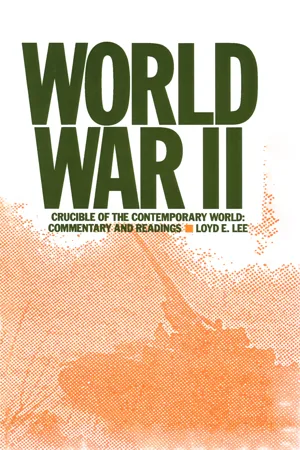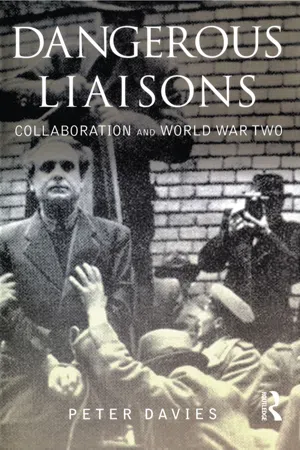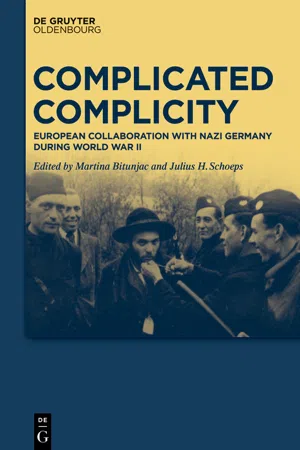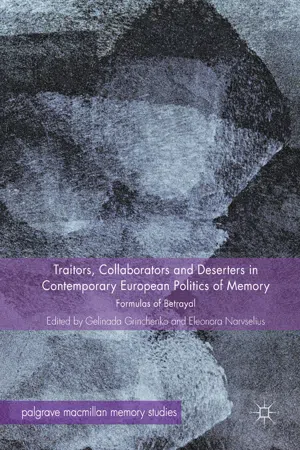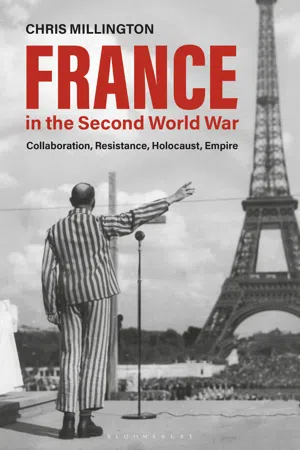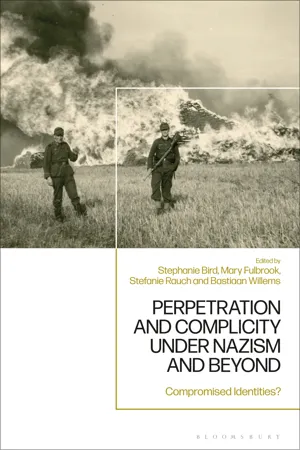History
Nazi Collaboration
Nazi collaboration refers to the cooperation or support provided by individuals, groups, or governments in Nazi-occupied territories during World War II. This collaboration took various forms, including military, political, and economic assistance to the Nazi regime. It often involved local authorities or organizations working with the Nazis to implement their policies, including the persecution and extermination of Jews and other targeted groups.
Written by Perlego with AI-assistance
7 Key excerpts on "Nazi Collaboration"
- eBook - ePub
World War Two
Crucible of the Contemporary World - Commentary and Readings
- Lily Xiao Hong Lee(Author)
- 2016(Publication Date)
- Routledge(Publisher)
Part II Life under Nazi Occupation: Collaboration and the Holocaust- Introduction
- 3. Collaboration and Cooperation Jan Thomasz Gross
- 4. Conclusion: Collaborationist Profiles Bertram M. Gordon
- 5. The Final Solution Michael R. Marrus
- Further Reading for Part II
The precipitous German takeover of Western Europe from Norway to the Pyrenees in the late spring of 1940 shook western civilization to its core. It also brought on an unexpected new phenomenon of apparently willing cooperation with the enemy. Resistance to the Germans that summer was sporadic and easily contained. Commentators quickly refurbished the neutral word collaboration to let it now signify shameful cooperation with the enemy. This meaning soon established itself in most European languages and in popular usage. Collaboration and resistance, which at about the same time also took on a new connotation as an organized, covert opposition to German rule, became the twin poles of response to the German occupation.Certainly, cooperation with the enemy was not new—how else could one explain the growth of the European territorial states throughout the last few centuries as they incorporated new populations into previously foreign regimes? What was new was that in an age in which nationalism reigned supreme, collaboration spread so rapidly and settled in almost naturally as the norm, at least in Western Europe. Moreover, the Germans were greeted by vocal fascists and racists whose enthusiasm for Nazism was exceeded only by their own ambitions for a New Order at home. That this ideological commitment to a fascist Europe, which was largely compounded from the illusions of an odd assortment of local, radical rightists, played no important part in German plans suggests that the phenomenon of collaboration reflected a deep malaise in European society. When coupled with its opposite, the resistance, it supports the notion that the Second World War was in some respects a civil war within European nations as well as a struggle against the occupier. - eBook - ePub
Dangerous Liaisons
Collaboration and World War Two
- Peter Davies(Author)
- 2014(Publication Date)
- Routledge(Publisher)
8 As will become apparent in due course, this book also seeks to analyse collaboration as a broad, multi-faceted phenomenon rather than as something with stricter parameters.Up until now, we have focused almost exclusively on collaboration at the ‘top’ of society. However, in many states, the reality of the wartime situation was that ordinary people, groups and institutions, as well as political leaders and governments, had to wrestle with the ethical dilemma that could be summarised in the following question: to collaborate or not? Alternatively, they could take up a position somewhere in between.Ordinary people going about their normal everyday lives were forced to address the most terrible of quandaries. To frequent café bars used by German soldiers, or not? To form relationships, whether platonic or sexual, with representatives of the Nazi regime, or not? To trade with, and make money out of, the occupiers, or not?Likewise, across Europe, social groups and institutions had to examine their collective consciences. The Church: should it grant any legitimacy at all to Hitler and his puppet leaders? Trade unions: should they simply make way for Nazi-style industrial relations? The press: should it simply toe the line of (or put less kindly, ‘sell out to’) the rigorous censorship regime imposed by the occupying authorities? At the time, these were major dilemmas, and from the relative comfort of the twenty-first century, with hindsight on our side, we should not belittle their scale and gravity. The end result was a lot of ‘grey’. Only a minority of people engaged in full-blown collaboration; only a minority could claim to have avoided any contact with the Germans. - eBook - ePub
Complicated Complicity
European Collaboration with Nazi Germany during World War II
- Martina Bitunjac, Julius H. Schoeps, Martina Bitunjac, Julius H. Schoeps(Authors)
- 2021(Publication Date)
- De Gruyter Oldenbourg(Publisher)
In all of these countries different kinds of opposition and resistance to the ambitions and presence of Nazi Germany took place, and in all of them various forms of cooperation with Nazi Germany also took place. Readers who seek insights into the complexities of how each of the countries more specifically related to Nazi Germany during World War II are referred to the many very careful and detailed empirical research studies there are in each of the countries on both their respective resistance movements and collaborationism. 1 For the purpose of the present analysis, it will suffice to present a rough summary. Many elements of resistance and collaborationism that – from other perspectives than adopted for the purpose of this article – might be quite salient in the history of the respective nation will not be reported in this article. Collaborationism: Offensive and Defensive Cooperation Collaborationism refers to cooperation with the enemy against your own country in wartime. Usually it is regarded high treason. “Traitorous cooperation with the enemy” is a term often used with reference to the French Vichy Government, which cooperated closely with the Nazis from 1940–1944. Stanley Hoffman in his classic work on collaborationism in France (1968) 2 subdivided collaboration into involuntary, meaning reluctant recognition of the necessity to cooperate, and voluntary. Another distinction can be made between forced and ideological collaborationism. Both of these comprise deliberate services to an enemy. Whereas the first kind is service to an enemy based on perceived necessity for survival or avoidance of suffering, the second kind, ideological collaborationism, is advocacy for cooperation with an enemy power because this is seen as a champion of some desirable domestic transformations. The terms “collaborationism” and “collaboration” in the present essay will be used without any immediate implications of treason - eBook - ePub
- Gelinada Grinchenko, Eleonora Narvselius, Gelinada Grinchenko, Eleonora Narvselius(Authors)
- 2017(Publication Date)
- Palgrave Macmillan(Publisher)
11Apart from this institutional network of collaboration we should also mention the armed units of resistance of various political orientations, which fought against the Nazis but sometimes, for various reasons, persecuted the victims of the Nazi terror. There were also the regular men and women who tried to secure their existence under the German occupation of their country, and in some circumstances collaborated, either actively (for example by reporting the presence of Roma) or passively (for example by not offering assistance to those who tried to find a shelter). Eventually, in some rare situations, there were Roma people who collaborated with the Nazis in the persecution of their brethren.9.2 Forms of Collaboration
The phenomenon of collaboration should be perceived as a complex one and involving the whole spectrum of activities and attitudes located between ardent resistance and enthusiastic support of Nazi rule based on ideological affinity.12 Even the extremes of this spectrum could be morally ambiguous because it happened sometimes that anti-Nazi fighters acted violently against the victims of the Nazis and, on the other hand, individuals who had been part of collaborating institutions sometimes offered assistance to those victims.It seems, therefore, that it would be useful to develop the concept of collaboration in the genocide of the Roma as an interactive, negotiable process of changing and often contingent dynamics,13 in which we experience intertwined layers of personal, local, and institutional policies or initiatives. This approach takes up the proposal of “re-examining the concept of collaboration,” expressed in the introduction to this volume (Chap. 1 ), in line with Jan T. Gross’s idea of the “interactive nature of betrayal”.14 - eBook - ePub
France in the Second World War
Collaboration, Resistance, Holocaust, Empire
- Chris Millington(Author)
- 2020(Publication Date)
- Bloomsbury Academic(Publisher)
As some French believed in 1940, it was a collaboration between a farmer and his pig. 5 Collaboration took a number of forms. Stanley Hoffmann termed the collaboration between the Vichy regime and the Occupier ‘state collaboration’ or ‘collaboration d’Etat’. Historians have identified other forms of collaboration, from ideological imitation (termed ‘collaborationism’) to economic, military, sexual and emotional collaboration. The term ‘collaboration’ itself is therefore problematic. The word is a blunt instrument and a label whose association with co-operation between the Axis powers and indigenous populations during the Second World War has rendered it ‘synonymous with treason’. 6 Such an understanding both obscures the many motivations behind the behaviour and implies a value judgement based on its opposition to the virtue of ‘resistance’. Vesna Drapac and Gareth Pritchard have argued that ‘[t]he historiography of World War II has never escaped from this need to identify resisters to celebrate and collaborators to castigate’. 7 Consequently, in the case of France, Philippe Burrin casts doubt on the validity of the term ‘collaboration’ in contexts other than the political, seeing in it a tool used to denounce, blacken and tarnish. Burrin contends that some form of co-operation between French and Germans was inevitable because a whole nation cannot resist. He prefers the word ‘accommodation’, defined as, ‘a regular phenomenon in almost any occupation, where certain points or interfaces of contact are inevitably created and some adjustment to the new situation has to be made’, to better describe Franco-German relations during the Second World War. 8 Burrin in turn defined different forms of accommodation. Structural accommodation allowed the country to continue to function; it encompassed, for example, the continued delivery of public services such as the mail. Deliberate accommodation looked to assist the policy of the Occupier, whether directly or indirectly - eBook - ePub
Perpetration and Complicity under Nazism and Beyond
Compromised Identities?
- Mary Fulbrook, Bastiaan Willems, Stephanie Bird, Stefanie Rauch, Mary Fulbrook, Bastiaan Willems, Stephanie Bird, Stefanie Rauch(Authors)
- 2023(Publication Date)
- Bloomsbury Academic(Publisher)
There is now a much greater appreciation of the degree of knowledge and involvement of many elements of Nazi society in the actions of the Nazi state, as bystanders and indirect perpetrators as well as direct perpetrators. As Mary Fulbrook states:Whatever terms we adopt to describe people’s behaviour at the time or later, some things are quite clear. Few who lived through this period could avoid being involved, at some point, on one side or another—sometimes also crossing sides, in complex, ambivalent, and distressing ways, moving from being a committed Nazi to a member of a resistance group, from a victim to a collaborator, from a doubter to a murderer, and from an upright citizen to a shriveled outcast.12This paints a complex and nuanced picture of complicity, both in terms of the extent of those involved and the fluid categories to which they can be assigned. In this context, it is very difficult to understand how the Holocaust could come about without tackling the facets of Nazi society that contributed to such widespread and ambivalent participation by otherwise ‘ordinary’ Germans. The legal system, this chapter claims, is one of those facets.This chapter explores how Nazi law and legal institutions helped to construct the atmosphere of ideological consensus within which individually abhorrent and otherwise inexplicable decisions were taken. In addressing the constitutive aspect of the Nazi legal system, this chapter aims to bring the insights of the ‘voluntarist turn’13 in Nazi historiography together with a theoretical understanding of Nazi law that goes beyond its interpretation as ‘legal terror’ and a concern with whether or not it ought to be considered as valid law. To develop its argument it will make a number of related points: (i) that the dominant academic understanding of the Nazi legal system guards against its ideological role being fully explored, and therefore its influence on normative decision‑making by perpetrators; (ii) that part of acknowledging law’s own historical complicity with the Nazi project involves accepting its constitutive role in the Holocaust; and (iii) that legal norms did operate to help construct the normative environment within which people acted in the Third Reich. This is in line with Louis Althusser’s general claim that law belongs to both what he terms the ideological state apparatus (ISA) and the repressive state apparatus (RSA),14 - eBook - ePub
- Mercedes Camino(Author)
- 2018(Publication Date)
- Palgrave Macmillan(Publisher)
2The wide-spectrum of collaboration in Europe included the willing partnership of pro-fascist parties, such as the Norwegian Nasjonal Samling , the Croat Ustaša or the French Parti populaire Français and Rassemblement national populaire . It also comprised the nationalist or anti-communist resistance of some Eastern countries or regions, such as the Baltic nations , Poland or Ukraine, which reacted against Soviet or Stalinist dominance, often with the additional ingredient of long-lasting antisemitism , as well the association of Bolshevism with Judaism. Antisemitism also had deep roots in other countries, including Austria , where the fact that a small proportion of Jews were overrepresented in professions such as doctors or lawyers was fitted into the worldwide conspiracy to dominate the world articulated in the infamousProtocols of the Elders of Zion.In contrast with Eastern or Central European countries, collaboration with the Germans had different motivations in France , where the concept originates. The term was coined by the leader of the Rassemblement national populaire , Marcel Déat , who wrote in the party’s journal, L’Œuvre , on 4 November 1940, that true patriots should encourage and strengthen the relationship between France and Nazi Germany beyond mere ‘collaboration ’. This was the situation in which the hero of World War I , Marshal Pétain , stepped in, presenting himself as a model Frenchman in contemporary posters that stressed his ‘Frenchness’ as Catholic, traditional and conservative. As Richard Golsan remarks, this ‘realistic’ image demythologized the resistance by justifying collaboration as arising from ‘fate’ or ‘human nature’, downplaying its ideological and socio-political dimensions.3
Index pages curate the most relevant extracts from our library of academic textbooks. They’ve been created using an in-house natural language model (NLM), each adding context and meaning to key research topics.
Explore more topic indexes
Explore more topic indexes
1 of 6
Explore more topic indexes
1 of 4
